The Electromagnetic Field Analytical Solution Analysis to Downhole Current Injection Ranging
Abstract
:1. Introduction
2. Signal Model and Electromagnetic Field Distribution Analysis
2.1. Signal Model
2.2. The Primary Electric Potential in Active Region Analysis
2.3. The Secondary Electric Potential Analysis
2.4. The Electromagnetic Field Analysis
3. Simulation Experiments
4. Conclusions
Author Contributions
Funding
Institutional Review Board Statement
Informed Consent Statement
Data Availability Statement
Conflicts of Interest
Appendix A. The Derivation of (20)
References
- Evensen, K.; Sangesland, S.; Johansen, S.E.; Raknes, E.B.; Arntsen, B. Relief well drilling using surface seismic while drilling. In Proceedings of the IADC/SPE Drilling Conference and Exhibition, Fort Worth, TX, USA, 4–6 March 2014. [Google Scholar]
- Goobie, R.B.; Allen, W.T.; Lasley, B.M.; Corser, K.; Perez, J.P. A guide to relief well trajectory design using multidisciplinary collaborative well planning technology. In Proceedings of the IADC/SPE Drilling Conference and Exhibition, London, UK, 17–19 March 2015. [Google Scholar]
- Mansouri, V.; Khosravanian, R.; Wood, D.A. Optimizing the separation factor along a directional well trajectory to minimize collision risk. J. Petrol. Explor. Prod. Technol. 2020, 10, 2113–2125. [Google Scholar]
- Mohamed, A. Anti-collision planning optimization in directional wells. Petrol. Coal 2020, 62, 1144–1152. [Google Scholar]
- Upchurch, E.; Oskarsen, R.; Chantose, P.; Emilsen, M.; Morry, B. Relief well challenges and solutions for subsea big-bore field developments. SPE Drill. Complet. 2020, 35, 588–597. [Google Scholar]
- Zhao, W.; Pang, D.; Zhang, Y.; Leng, X. Location selection of deepwater relief wells in south China sea. Petroleum Explor. Dev. 2016, 43, 315–319. [Google Scholar]
- Poedjono, B.; Nwosu, D.; Martin, A. Wellbore positioning while drilling with LWD measurements. Petrophysics 2019, 60, 450–465. [Google Scholar] [CrossRef]
- Dou, X.; Liang, H.; Liu, Y. Anticollision method of active magnetic guidance ranging for cluster wells. Math. Probl. Eng. 2018, 2018, 7583425. [Google Scholar] [CrossRef]
- Diao, B.; Gao, D.; Li, G. Development of static magnetic detection anti-collision system while drilling. In Proceedings of the 2016 International Conference on Artificial Intelligence and Engineering Applications, Hong Kong, China, 12–13 November 2016. [Google Scholar]
- Poedjono, B.; Alatrach, S.; Martin, A.; Goobie, R.B.; Allen, W.T.; Sweeney, E. Active acoustic ranging to locate two nearby wellbores in deepwater gulf of Mexico. In Proceedings of the SPE Annual Technical Conference and Exhibition, San Antonio, TX, USA, 9–11 October 2017. [Google Scholar]
- Liu, C.; Dang, J.; Yang, L.; Zhou, Y.; Luo, X.; Dang, B. Space-time pulsed eddy current array for NDT of wellbore casings based on MIMO technique. Proc. IEEE Trans. Instrum. Meas. 2024, 73, 6000112. [Google Scholar]
- Hanak, F.C.; Estes, R. High speed, continuous single well magnetic ranging. In Proceedings of the IADC/SPE Drilling Conference and Exhibition, London, UK, 17–19 March 2015. [Google Scholar]
- Hao, X.; Wang, Y.; Dang, B.; Li, F.; Xu, L.; Liu, Z. Research on electromagnetic detection and positioning methods and tools for relief wells. Pet. Drill. Tech. 2021, 49, 75–80. [Google Scholar]
- Oskarsen, R.T.; Wright, J.W.; Fitterer, D.; Winter, D.; Nekut, A.; Sheckler, J. Rotating magnetic ranging service and single wire guidance tool facilitates in efficient downhole well connections. In Proceedings of the SPE Annual Technical Conference and Exhibition, Amsterdam, The Netherlands, 17–19 March 2009. [Google Scholar]
- ISCWSA. Well Intercept Sub-Committee Ebook; UHI House: Inverness, UK, 2016; Chapter 3; pp. 25–34. [Google Scholar]
- Feng, R.; Luo, X.; Yang, L.; Dang, B. Electromagnetic ranging system for rescue wells based on ring MEMS sensors. In Proceedings of the 2024 3rd International Conference on Energy and Electrical Power Systems, ICEEPS, Guangzhou, China, 14–16 July 2024; pp. 1162–1167. [Google Scholar]
- Diao, B.; Gao, D. A magnet ranging calculation method for steerable drilling in build-up sections of twin parallel horizontal wells. J. Nat. Gas Sci. Eng. 2015, 27, 1702–1709. [Google Scholar] [CrossRef]
- Wu, Z.; Gao, D.; Diao, B. An investigation of electromagnetic anti-collision real-time measurement for drilling cluster wells. J. Nat. Gas Sci. Eng. 2015, 23, 346–355. [Google Scholar] [CrossRef]
- Wu, P.; Wei, M. Magnetization influence analysis of the casing and drill pipe in shale gas dual horizontal well Rotating Magnet Ranging System drilling process. Energy Sci. Eng. 2020, 8, 3186–3199. [Google Scholar] [CrossRef]
- Relief Well Planning & Magnetic Ranging; Halliburton Co.: Houston, TX, USA, 2020; pp. 20–30.
- Yu, R.; Diao, B.; Gao, D. Optimal selection method of magnetic ranging tools for relief well engineering based on the measurement error of the adjacent well distance. Pet. Drill. Tech. 2021, 49, 118–124. [Google Scholar]
- Dang, J.; Yang, L.; Zhou, Y.; Dang, B. Sparsity-based nondestructive evaluations of downhole casings technique using the uniform linear array. Appl. Sci. 2024, 14, 6588. [Google Scholar] [CrossRef]
- Liu, C.; Yang, L.; Zhang, Z.C.; Dang, B. Application of borehole transient electromagnetic system in relief well drilling: A case study. In Proceedings of the 2021 3rd International Conference on Intelligent Control, Measurement and Signal Processing and Intelligent Oil Field (ICMSP), Xi’an, China, 23–25 July 2021. [Google Scholar]
- Yang, L.; Dang, B.; Liu, C.; Xu, L.; Ren, Z.; Dang, R. Borehole transient electromagnetic array based relative attitude deteation for relief well drilling. In Proceedings of the 2021 3rd International Conference on Intelligent Control, Measurement and Signal Processing and Intelligent Oil Field (ICMSP), Xi’an, China, 27–29 December 2019. [Google Scholar]
- Peng, H.; Zhao, Y.; Sun, X.; Nie, Z. Numerical investigation of active magnetic ranging method for relief well projects. In Proceedings of the 2021 IEEE International Geoscience and Remote Sensing Symposium IGARSS, Brussels, Belgium, 11–16 July 2021. [Google Scholar]
- Zhang, S.; Diao, B.; Gao, D. Numerical simulation and sensitivity analysis of accurate ranging of adjacent wells while drilling. J. Pet. Sci. Eng. 2020, 195, 107536. [Google Scholar] [CrossRef]
- Dang, J.; Yang, L.; Qin, C.; Zhao, Q.; Ji, X.; Guo, C.; Dang, B. Accurate ranging of adjacent well using compressive sensing-based current injection with a uniform sensor array. Geoenergy Sci. Eng. 2024, 233, 212468. [Google Scholar]
- Wu, Z.; Fan, Y.; Wang, J.; Zhang, R.; Liu, Q.H. Application of 2.5-D finite difference method in logging-while-drilling electromagnetic measurements for complex scenarios. IEEE Geosci. Remote Sens. Lett. 2020, 17, 577–581. [Google Scholar]
- Wu, S.; Zhao, K.; Yang, S.; Hong, D.; Liu, Q.H. Electromagnetic fields in full-parameter uniaxial anisotropic planar stratified media. IEEE Trans. Antennas Propag. 2024, 72, 2564–2577. [Google Scholar]
- Wang, X.; Shen, J.; Su, B. 3-D Crosswell electromagnetic inversion based on general measures. IEEE Trans. Geosci. Remote Sens. 2021, 59, 9783–9795. [Google Scholar]
- Blowout and Well Control Handbook, 2nd ed.; GSM Co.: Amarillo, TX, USA, 2017; pp. 303–336.
- Dang, J.; Zhao, Q.; Guo, C.; Li, J.; Zhang, L.; Tang, T.; Dang, B.; Yang, L.; Liu, C. Long-Distance Crosswell EM Logging of Copper Ore Using Borehole-Surface Current Injection in Slim Holes. IEEE J. Sel. Top. Appl. Earth Observ. Remote Sens. 2022, 15, 5559–5569. [Google Scholar] [CrossRef]
- Xu, J. Electromagnetic Field and Electromagnetic Wave in Layered Media; Petroleum Industry: Beijing, China, 1997; pp. 1–244. [Google Scholar]
- Werner, W. Hamilton-Operator im elektromagnetischen Feld. In Hamiltonsche Mechanik und Quantenmechanik; Springer: Berlin/Heidelberg, Germany, 2023; pp. 439–440. [Google Scholar]
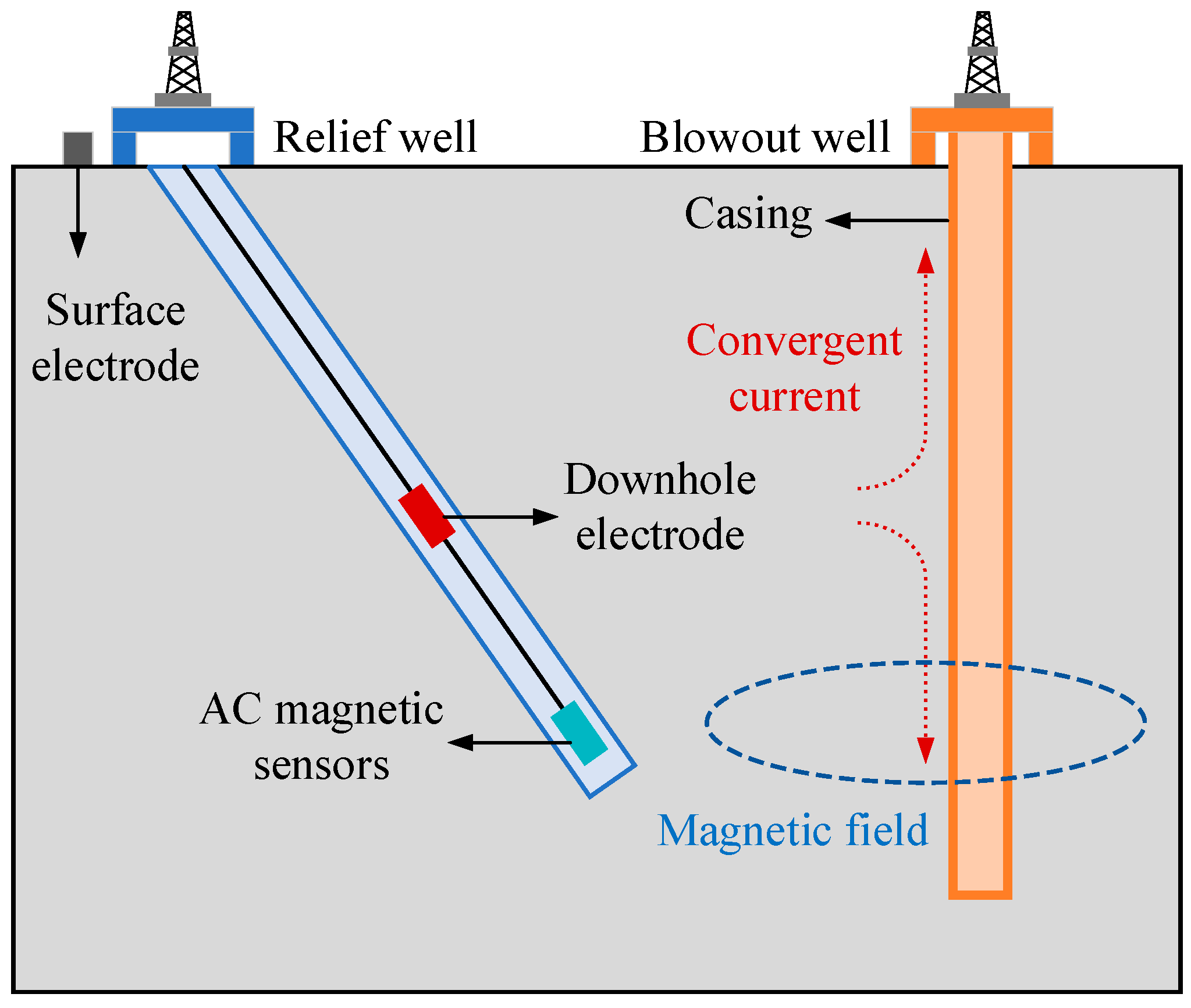
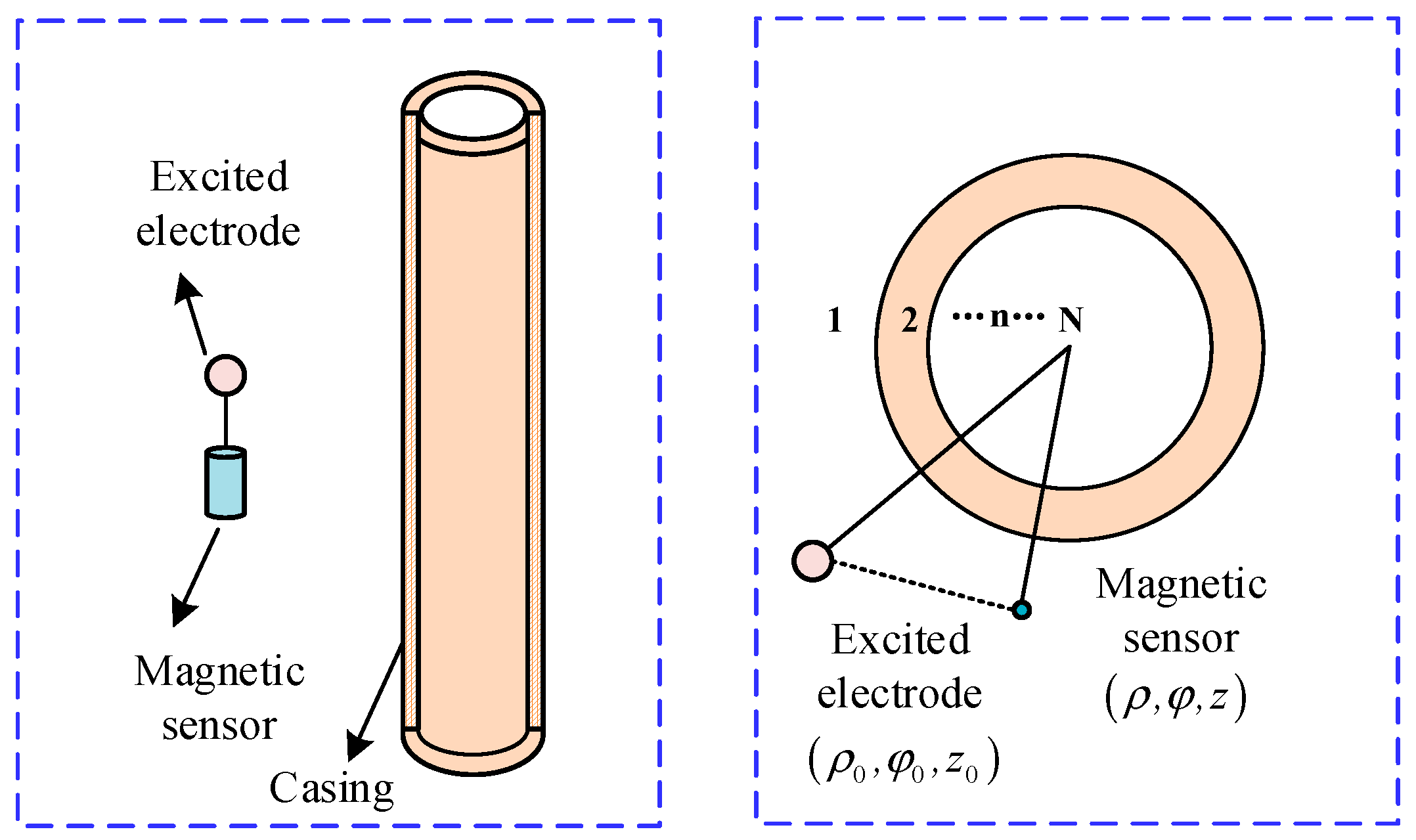
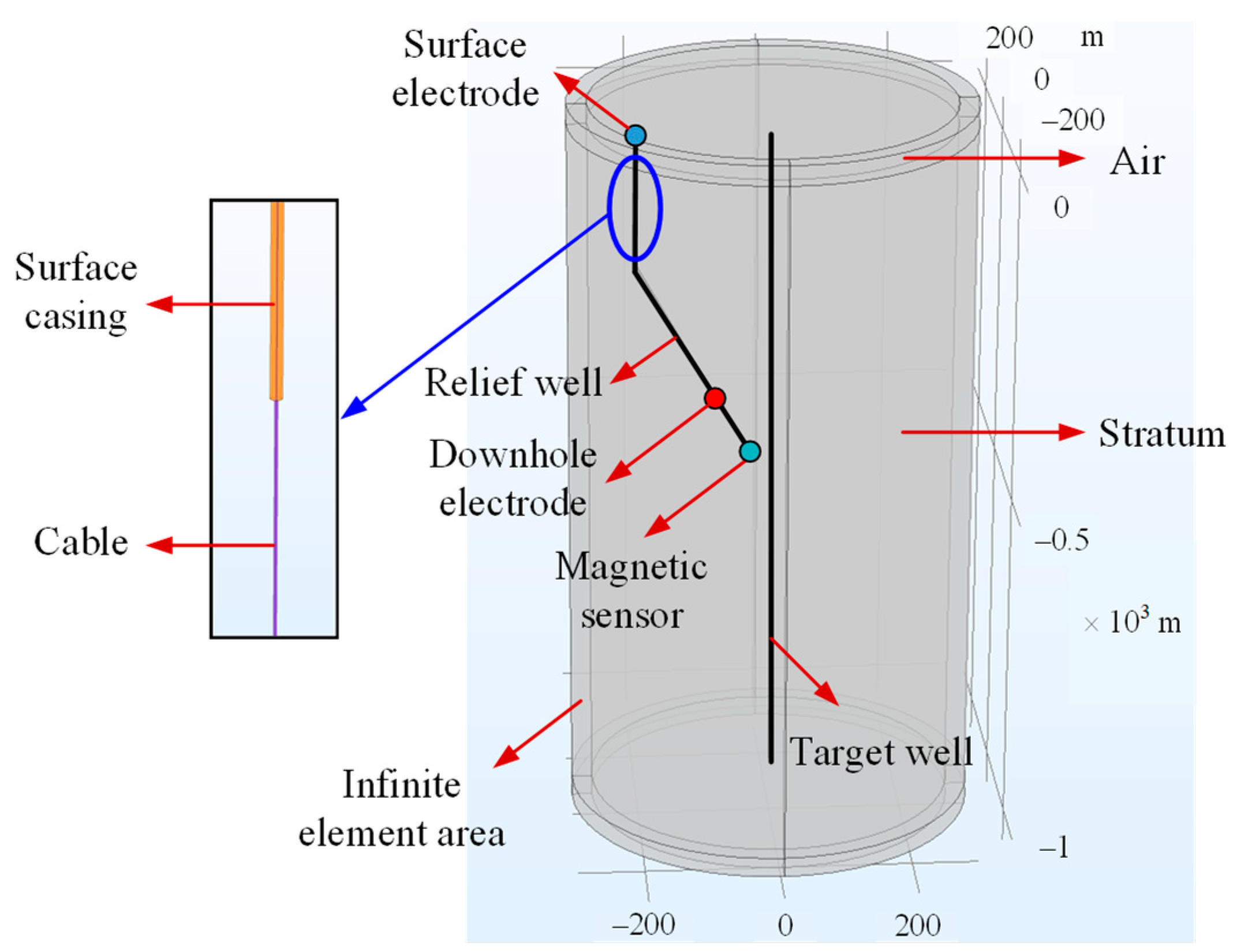
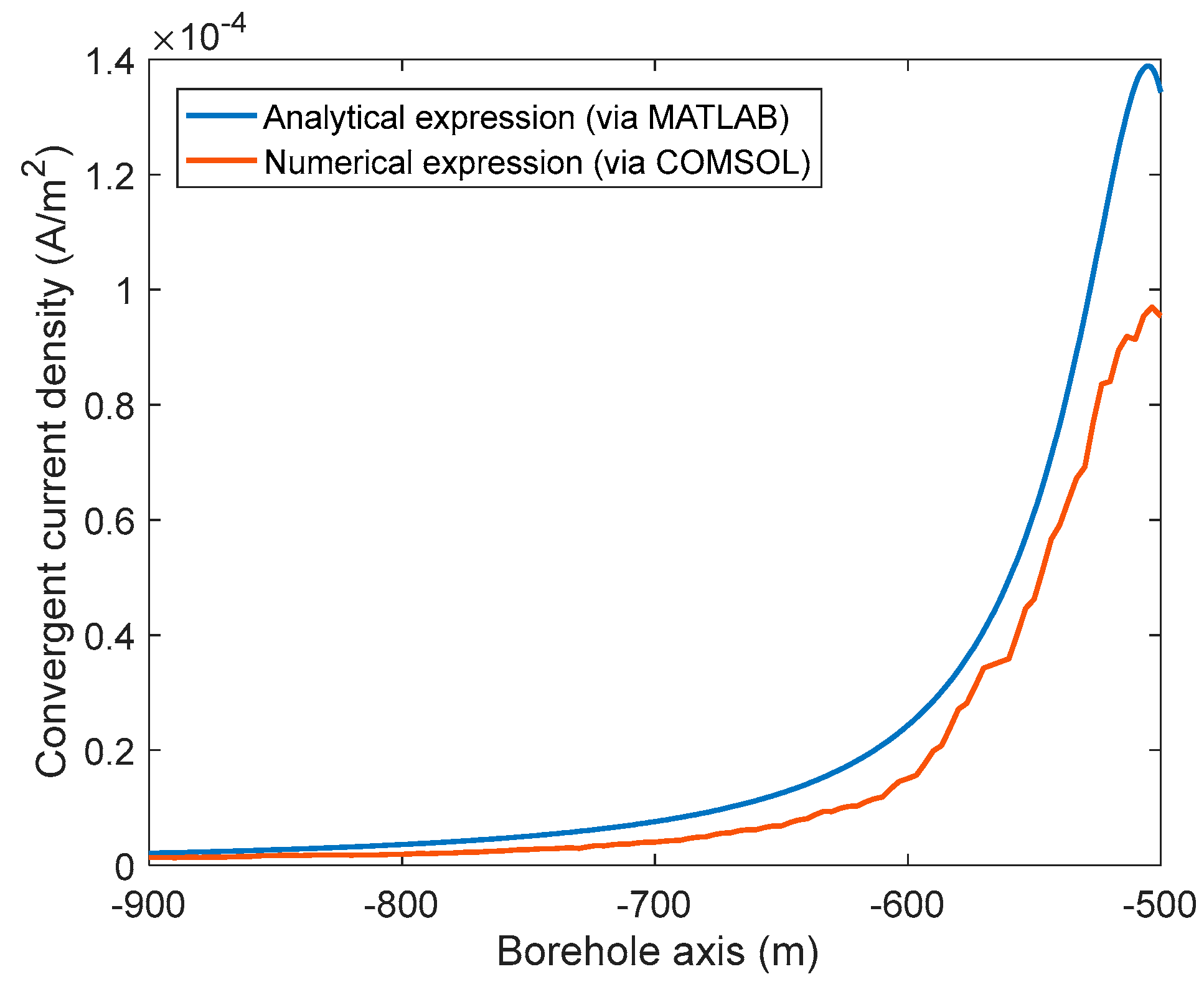


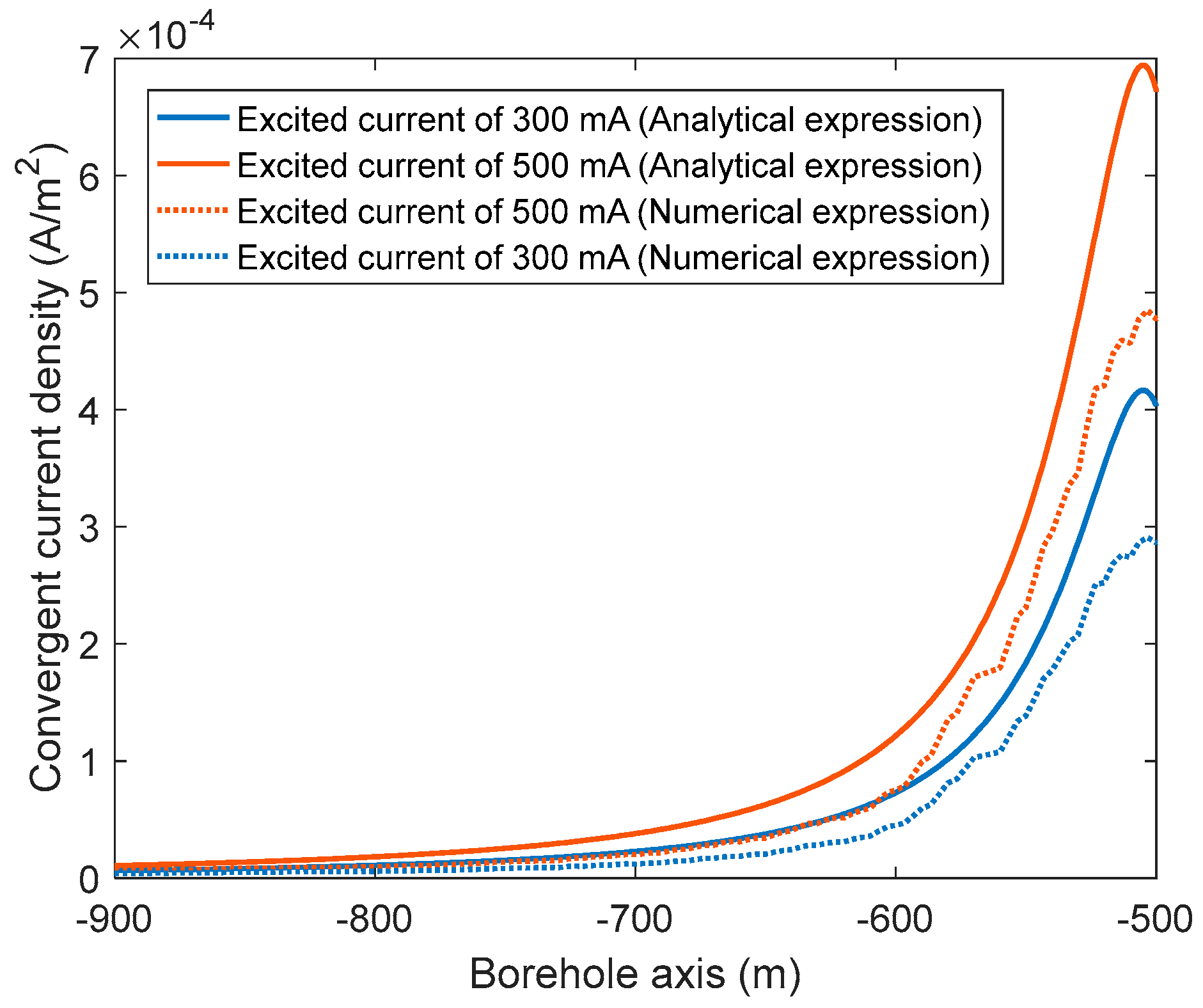
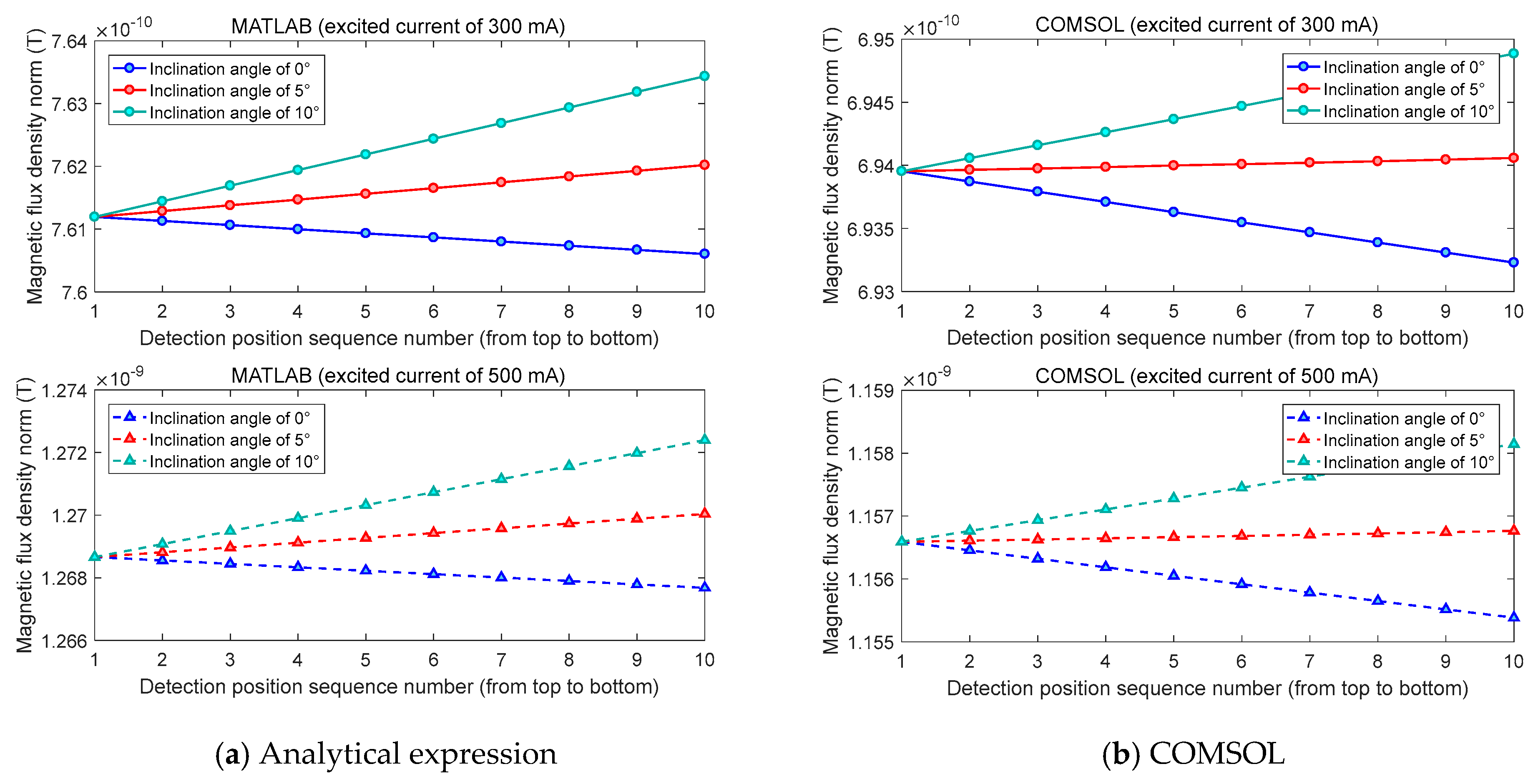

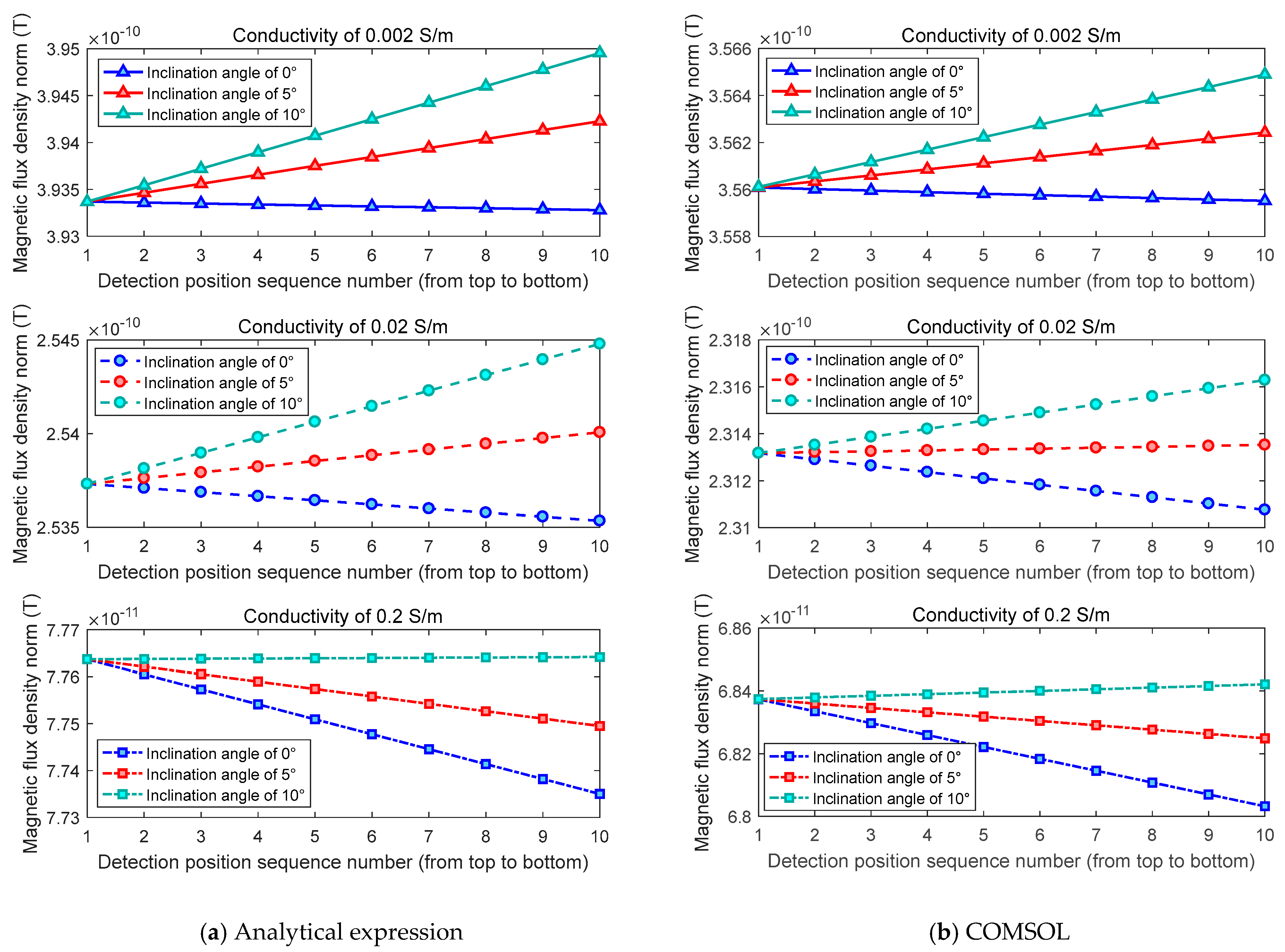
| Parameters | Value |
|---|---|
| Position of Downhole Electrode | 500 m underground, 30 m away from the target well |
| Surface Electrode | On the ground, 200 m from the target well |
| Target Well Length | 1000 m |
| Stratum Conductivity | 0.02 S/m |
| Target Well Conductivity | 107 S/m |
| Current intensity | 100 mA |
| Range of ρ | 0–30 m |
| Range of φ | 0–2π |
| Range of z | −1000–0 m |
Disclaimer/Publisher’s Note: The statements, opinions and data contained in all publications are solely those of the individual author(s) and contributor(s) and not of MDPI and/or the editor(s). MDPI and/or the editor(s) disclaim responsibility for any injury to people or property resulting from any ideas, methods, instructions or products referred to in the content. |
© 2025 by the authors. Licensee MDPI, Basel, Switzerland. This article is an open access article distributed under the terms and conditions of the Creative Commons Attribution (CC BY) license (https://creativecommons.org/licenses/by/4.0/).
Share and Cite
Qin, C.; Wang, Y.; Ji, X.; Feng, Y.; Ye, L.; Li, W.; Zhou, Y.; Dang, B. The Electromagnetic Field Analytical Solution Analysis to Downhole Current Injection Ranging. Appl. Sci. 2025, 15, 3741. https://doi.org/10.3390/app15073741
Qin C, Wang Y, Ji X, Feng Y, Ye L, Li W, Zhou Y, Dang B. The Electromagnetic Field Analytical Solution Analysis to Downhole Current Injection Ranging. Applied Sciences. 2025; 15(7):3741. https://doi.org/10.3390/app15073741
Chicago/Turabian StyleQin, Caihui, Yu Wang, Xinbiao Ji, Yang Feng, Lanchun Ye, Wenbo Li, Yan Zhou, and Bo Dang. 2025. "The Electromagnetic Field Analytical Solution Analysis to Downhole Current Injection Ranging" Applied Sciences 15, no. 7: 3741. https://doi.org/10.3390/app15073741
APA StyleQin, C., Wang, Y., Ji, X., Feng, Y., Ye, L., Li, W., Zhou, Y., & Dang, B. (2025). The Electromagnetic Field Analytical Solution Analysis to Downhole Current Injection Ranging. Applied Sciences, 15(7), 3741. https://doi.org/10.3390/app15073741







